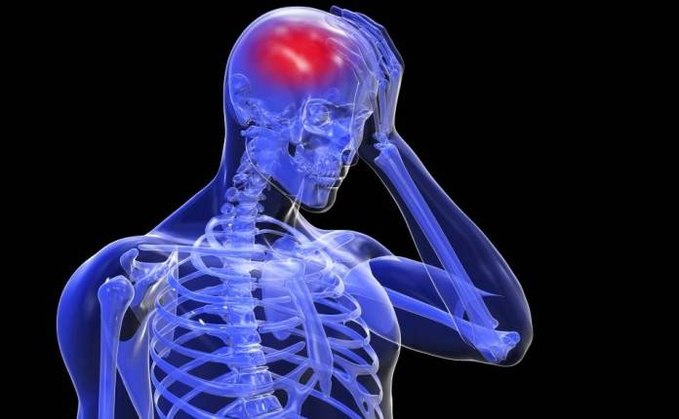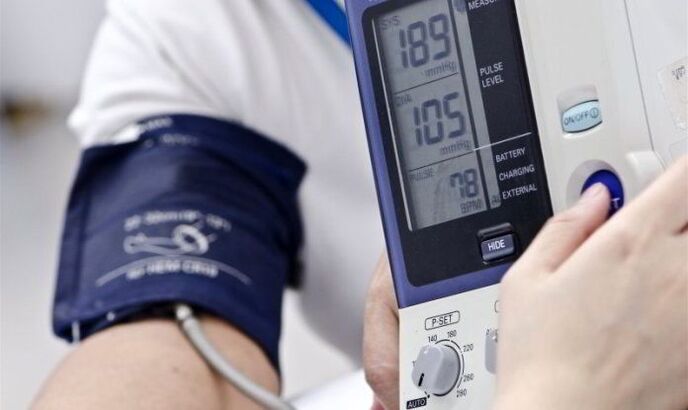Cervical osteochondrosis is a disease of the spine, which are characterized by disorders of the intervertebral discs.Pathology is characteristic of the elderly, but a person of any age can encounter it.The vulnerable discomfort causes one of the main signs of this disease - severe pain.The patient should know what cervical osteochondrosis is dangerous and with what problems it will have to face.
The specifics of the disease
The cervical region is one of the most removable parts of the body, and has regular loads.With the development of osteochondrosis, the shift of vertebrae, which leads to compression of numerous vessels and nerves.The main complexity of the pathology is that its characteristic dystrophic changes affect the roots of the spinal nerve and the discs of intervertebral space.Because of this, the brain remains without the necessary oxygen, the blood supply is lost.

In the risk area, there are mainly elderly in which the disease develops against the backdrop of metabolic disorders, and changes in the structure of vertebrae and intervertebral discs are associated with age.The reason for developing such violations can also be:
- Salt deposition;
- insufficient physical activity;
- Improper food;
- injuries;
- frequent hypothermia;
- Hormone problems;
- Excess weight;
- Chronic diseases.
Osteochondrosis also provokes a long -term body presence in a position, which puts the employee and office drivers under the stroke.
Symptoms of osteochondrosis
In the initial stage of the disease, the symptoms are almost invisible, anxiety can only cause mild neck pain.But as the pathology develops, the symptoms are gradually increasing.
The cervical back osteochondrosis can be identified by the following signs:
- severe pain in the neck, nap, soup;
- regular migraine;
- the weakness of the hands;
- Neck mobility is limited;
- When you turn your head, the beads are pressed;
- Hearing problems;
- A characteristic bell appears in the ears;
- Discomfort in the throat.
In the initial stages, pain syndrome manifests itself only during movement, when it bends or turns the neck.Over time, the pain occurs even when the position of the hands changes.
Potential complications
If cervical osteochondrosis is not treated, degenerative processes in the intervertebral discs will lead to the loss of their main functions and a decrease in density.Excessive spine mobility will gradually develop, muscles, joints and ligaments will suffer.Pressure on nerve endings and spinal cord will only intensify, which will lead to an increase in symptoms and the development of new pathological phenomena.

Frequent migraines
For the most common consequences of cervical back osteochondrosis, you can calculate a headache.This is because it is in this site that is the vertebral artery, which is responsible for the distribution of oxygen and blood in the brain.
As the strength of the disk changes, the depreciation functions are violated.The deformed vertebrae suppresses the artery, interfering with the blood circulation and the "distribution" of the necessary oxygen.Muscle jumps are developing.
After pain, simultaneous symptoms often follow:
- nausea;
- vomiting;
- sharp increase in pressure;
- tingling in the shoulder edges;
- Weakness throughout the body.
With heavy attacks, it is desirable to relax as much as possible, it is better in a horizontal position.An unpleasant syndrome can remove the sedative or cold compresses, while the massage is useless.
Problems with vision
Complications of cervical osteochondrosis often affect vision organs: in this part of the spine has sleepy and vertebral arteries, which are responsible for the blood flow to the central visual structure.Compression of nerve roots and blood vessels leads to hypoxia and cause a decrease in vision.
Along with vertebral artery syndrome, symptoms such as:
- fog
- darkening in the eye;
- the appearance of "flies" or colored spots;
- bifurcation;
- excessive stress of the optical nerve;
- dizziness;
- nausea

During the examination, a specialist may notice a narrowing of the arterial vessels of the eye retina, less often there is swelling of the optical nerves.Also, against the background of the disease, glaucoma may appear, associated with increased pressure and intraocular pain.
Hearing problems
Due to the compression of the vertebral artery and nerve roots, hearing loss is possible by 20-30%.The neglected osteochondrosis of the cervix can lead to complete deafness.To avoid this, you should contact a doctor on the first symptoms of the disease.
A slight hearing loss is reversible: in addition to the treatment of the drug prescribed by a physician, the patient needs special exercises or massage of ear shells.Watching TV or listening to music is better in a small volume to strain the hearing organs.
Hypotension or hypertension
Lowering or increasing blood pressure are very common consequences of cervical osteochondrosis.The greatest risk is hypertension, which are characteristic:
- Pulse okomatization;
- Increased sensitivity to temperatures;
- sleep disturbances;
- nose bleeding;
- dyspne;
- heart pain;
- Sweating.
The higher the blood pressure, the greater the load on the heart, which leads to its fast ear.As a result, heart failure develops.In hypertension, atherosclerosis develops faster, which is dangerous with a stroke.
Mortgage does not pose a direct threat to life, but greatly affects its quality.The body experiences oxygen hunger, which affects the patient's overall well -being.Hypotonia is characterized by violations of the supply of venous and arterial blood, and this involves disturbances in limb sensitivity.Among the possible complications are myocardial infarction.

Vegetables -Diston vascular
Dystonia -Vascular Distonia is a general determination of the syndrome, which can affect some systems of the body and organs.Most pathology, cardiovascular system and peripheral nerves suffer from pathology.The patient experiences constant anxiety and sharp emotional differences.Frequent panic attacks are also possible, and the heart rate becomes more frequent.
Symptoms of dystonia can be lubricated or disguised as other diseases.The consequences of osteochondrosis of the cervical region in this case are also no more pleasant.So the gastrointestinal tract often suffers: nausea and vomiting, diarrhea, constipation and severe abdominal pain are possible.Disordishes of the gallbladder or liver are possible.Patients often complain of tachycardia, pressure with pressure and heart pain.
Intervertebral hernia
With an intervertebral hernia, disk fragments are "elongated" in the spinal canal or fall out.The initial stage of this pathology is called extension.The integrity of the intervertebral disc does not disturb it, but there is a slight bone extension in the spinal canal.At this stage, pressure on the roots of the spinal cord, so the main symptom is the poor pain that occurs during movement.In later stages, the pain syndrome has improved.
The mobility of the vertebrae gradually decreases.Muscle tension has improved, even if the patient appears to be in a calm condition.You may also notice periodic weaknesses in the upper parts of the hands or on the wrists.The numbness of the hands appears and a tingling sensation often occurs near the thumb.
This is what is the dangerous osteochondrosis of the cervical spine with hernia: it has a serious load on the artery, which passes near the vertebral column and is needed for accurate blood supply to the brain.If excessive patient pressure occurs, ischemic stroke may be expected.
A large hernia is dangerous for inflammation of the surrounding ligaments - this is filled with cervical radiculus.Only timely treatment can prevent complications.The patient should hear his body carefully and in the first symptoms consult a doctor.Doubts should cause:
- sharp attacks of nausea for no apparent reason;
- darkening in the eye when moving;
- noise in the ears when you turn your head;
- Attracting the sensations in the neck with a long stand in a standing position.
The most serious complications are the risk of irreversible paralysis of one or two hands.The cerebral nerve atrophy leads to this, which is located in the cervical region.If the hernia begins to put pressure on the blood vessels, they will gradually die, which will lead to an innovation of a number of organs.
Barrel syndrome
Vestibular barrel syndrome is a condition in which the patient experiences a strong dizziness that accompanies the loss of orientation.
The attacks arise with a sharp lift, turning it quickly or throwing their heads back.Characteristic of the state:
- noise in the ears;
- nausea;
- visual impairment;
- The feeling that everything is rotating and floating in front of his eyes.
The main reason for the pathology is the lack of blood supply, which implies the malfunction of the vestibular apparatus.The syndrome will occur more and more often as osteochondrosis develops.
Glorious minute syndrome
Launched osteochondrosis is dangerous with neuro-vascular disorders of the throat and larynx.The syndrome is characterized by:
- Hoareness;
- difficulties when swallowed;
- the constant sensation of a throat coma;
- dryness and pain;
- Complete loss of voice.
The syndrome occurs suddenly and is associated with dizziness.
Bar Syndrome Lie
The second name of pathology is vertebral artery syndrome.The reason for its development is the stenosis (narrowing) of the vertebral canal, in which the spasms of the vertebral artery occur and the compression of the blood vessels and nerves.
Symptoms include:
- hypertension;
- nausea;
- tachycardia;
- Eye carving;
- noise in the ears;
- loss of coordination of movements;
- pulsating pain in the temples or in the occipital region.
With a sharp movement or turning the neck, the patient may lose consciousness.

Hypotolamic syndrome
At the same time, the hypothalamus suffers from the syndrome - a part of the brain that is responsible for metabolism, pressure, sleep, body temperature and a person's emotional reactions.Disordishes functional disorders can manifest by increasing or weakening the activity of the brain department.In the first case, the patient becomes frustrated, in the second - obstructed.
Symptoms often resemble neurasthenia, which manifests through:
- sleep disorders;
- dissatisfaction;
- nervousness;
- high fatigue;
- Mood instability.
A person loses the opportunity to concentrate, has problems with memorization.Unreasonable spread of anger are possible, appetite disappears, the desire of sexual desire.
It is better to prevent any disease than to treat, predicting the behavior of osteochondrosis is quite difficult.If there are risk factors, you should regularly perform a series of simple physical exercises that will increase the mobility of the vertebrae and eliminate blockage in the collar area.
The frequent appearance of any of the symptoms described is the obvious body signal about the problems that occur in it.At the same time, self -medication is useless, and without consulting with a specialist will not work.

















































